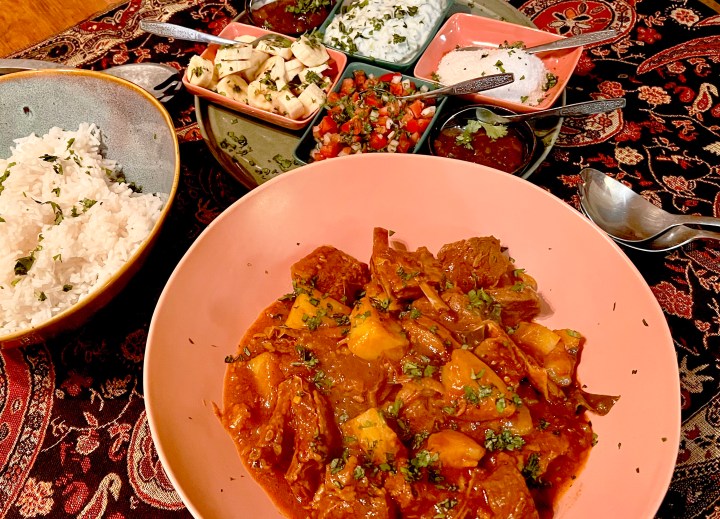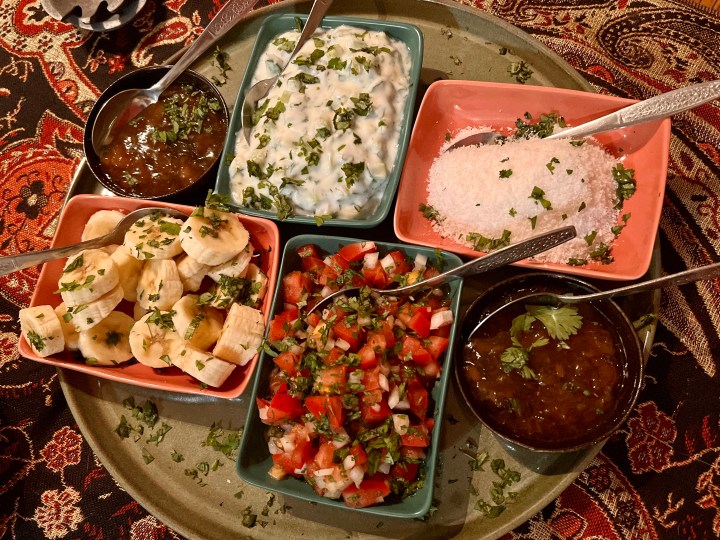BEST OF THE BEST
Throwback Thursday: Durban Curry

It’s the end result of trial and circumstance; a distillation of the India that indentured labourers had come from and what they made of the strange land they had made their new home. Durban Curry. Arguably, and for some of us undoubtedly, the greatest curry in the world.
Plenty of tomato, a fiery red hue, generous with the chillies, simple cooking oil rather than coconut oil or ghee, the essential masala mixed by a Durban spice merchant who knows what she’s doing and was born to it, and sambals on the side: these elements more or less define what we mean by “Durban curry”, those two words which have every South African salivating.
There’s much more of course. There are the inevitable twins at the core of any Durban curry, the garlic and ginger, as well as the masala of choice, never shy of the core spices of cinnamon, cumin, fennel, and assorted others such as turmeric, mustard seeds, fenugreek, curry leaves, some or all of which may be added depending on who is cooking the dish. Also present in almost every Durban lamb or mutton curry is potato in chunks, stewed in the pot to take on all the flavour. A poppadom or two on the side would never be out of place.
Recipes for “Durban curry” differ from cook to cook, kitchen to kitchen and restaurant to restaurant. But there are commonalities without which it would not be worthy of the name.
Now, let’s get the elephant out of the room: it must be plain for all to see that I am not Indian, but I am South African and a Durban curry is steeped in my very bones. I have adored it since I was a child, and though my palate has travelled far and wide, tasting many curries including the delightful vegetarian recipes that I have come to love in more recent years, for me there is nothing like a good old Durban mutton curry with all the expected sambals, from the tomato and onion via the chutneys to the banana and dessicated coconut to be sprinkled over the top. In any event, I’m a food writer. I cook Italian food but I’m not Italian. I cook Moroccan food but I’m not Moroccan. If I only cooked according to my birthright, I’d be making variations on a Yorkshire pudding every day. Yorkshire pudding filled with Durban curry… actually that’s not at all a bad idea; an alternative to a bunny chow…
But I defer to any Indian cook steeped from birth in the Durban tradition; I stand back in their presence and acknowledge that I can only ever operate in their shadows. I also never, ever, buy those little commercial boxes of curry, Rajah and the like. We only buy our masala when we visit family in KwaZulu-Natal, from a spice shop where the sari-clad lady is always surprised when these white people ask for a “very hot” mix.
Having said that, I take my curries very seriously, seeking balance of flavour and, on occasion, erring too shyly on the side of mild, even though my own palate favours a proper chilli kick. Like most actual Indian cooks of a good Durban curry, if I’m serving guests who are white like me, I’m sometimes tempted to make it milder. I’ve always thought this a pity, given that I’d rather a curry packed all the punch it can muster.
Generally, I keep potatoes out of a curry, but this time I wanted to make as close to a curry answering to that name as I could muster. So cubed potatoes went in, though not right from the start of building up the curry.
Some key factors:
Durban curry is made with cooking oil, such as sunflower or canola. This was one of the adaptations made when adapting to a new country and new circumstances. Yes, ghee is often used today. But an old-school Durban Indian cook would use simple cooking oil. An ‘oil slick’ on a Durban mutton curry is not frowned upon. In fact, for many it’s expected. I would, however, allow a curry to settle in the pot and scoop off some of the excess fat. Maybe.
The liquid component, once made, is called the gravy.
Durban lamb or mutton curries usually contain potatoes.
Some Durban curries also include peas.
Heat: Durban curries are hot. If you see a recipe for a Durban curry calling for “1 tsp” of masala, drop it right there and find another recipe. It’s tablespoons you’re after, preferably not only one, and preferably heaped. That’s before adding the chillies of course.
Spices: as well as an authentic Durban masala mix (and do trust a KZN spice merchant to mix it for you), you do also need the sweet spices such as cinnamon, cardamom and a hint of clove.
Tomato: an essential component of a Durban curry. Durban curries are reddish brown, from the tomato as well as the chillies and spices. A note on the oxheart tomatoes in this recipe: it is of course not traditional, but I had been given two large, sweet and spectacularly beautiful oxheart tomatoes and decided to use them, but regular ripe tomatoes or a can of them will do.
Onion: plain old white onions, chopped or sliced, are a key element in a Durban curry.
Ginger and garlic: you can’t make a good Durban curry without these twins.
The meat: lamb is widely popular, but my preference is for mutton, both lean and fatty. So in my recipe, the greater quantity of meat is lean, from the mutton leg, but there’s also a component of fatty ribs, which gives you the flavour advantage of both the bones and the fat.
Braising or toasting the spices: Either add spices to oil in the pot and simmer very gently for the essences to emerge, or briefly toast them dry, also on a low heat, for a similar result.
Salt: curry does need salt, and don’t be too shy with it. But add a little, taste, add, taste, until it seems right to you. Adding it all at once is risky.
Sambals: if the curry is going into a quarter loaf of bread to be served as a bunny chow, it needs grated carrot salad piled on top. Otherwise, the old South African way calls for any or all of the following: tomato, onion and chilli sambal with a little vinegar; optional cucumber raita (grated or chopped, in yoghurt, with optional chopped coriander); sliced banana; dessicated coconut; chutney.
Time: take it slow and low. Curries are not rushed. Slow cooking on a low heat is the trick.
Finally: coriander? I don’t remember chopped fresh coriander (cilantro) leaves being sprinkled on Durban lamb or mutton curries when I was a kid, but these days it’s often used. I use it. But I’d appreciate expert knowledge about this. If you know whether or not coriander leaf was always used traditionally in Durban curries, please write to me at [email protected].
The sambals:

Traditional sambals, from the tomato and onion and cucumber raita, via the chutneys to the banana and dessicated coconut, served in Mervyn Gers ceramic bowls. (Photo: Tony Jackman)
Tomato and onion: finely chop 1 large ripe tomato and 1 small onion and stir in 1 Tbsp white or brown vinegar and 1 Tbsp chopped coriander leaves. Grated carrot can also be included, unless you do a separate carrot salad as below.
Cucumber yoghurt: not deeply traditional but it does go well. mix 4 Tbsp chopped cucumber (peeled or not, as you like) with 4 Tbsp plain yoghurt, a little salt and white pepper, and 1 Tbsp chopped coriander.
Carrot: mix grated carrot with chipped chilli, vinegar and coriander.
Sliced banana and Mrs H.S. Ball’s finest would not go amiss.
Durban Mutton Curry
Ingredients
1.5 kg mutton leg, cubed
2 medium onions
3 garlic cloves, minced or grated
3 cm piece of fresh ginger, peel and grated
1 cinnamon stick
6 cardamom pods
2 star anise
½ tsp fenugreek seeds
2 bay leaves
A handful of curry leaves
1 tsp black mustard seeds
1 tsp ground turmeric
1 tsp ground fennel
1 tsp ground cinnamon
1 tsp ground coriander
1 tsp ground cumin
2 tsp chilli powder
3 or 4 heaped Tbsp Durban masala
2 finely chopped oxheart tomatoes or 4 medium tomatoes or 1 x 400 g can of chopped tomatoes
3 fiery red or green chillies, chopped
4 medium potatoes, peeled and cubed
Water
Salt, generously, to taste
Method
Add the cinnamon stick, cardamom pods, star anise, bay leaves, curry leaves, fenugreek and black mustard seeds to a deep, heavy pot and toast them briefly on a moderate heat, or braise them in oil. If toasting them dry, add the oil afterwards. Then add the ground spices (but not the masala or chilli powder) and cook gently for barely a minute. They must not be burnt.
Add the onion with the garlic and ginger and braise, stirring, for a few minutes. Add the cubed meat and braise, tossing the pieces so they brown evenly.
Add the chopped tomatoes, chopped chillies, masala and chilli powder (yes: a triumvirate of heat!) , stir well, add water to cover, bring to a boil, season with salt, then turn the heat down low, cover, and allow to simmer gently for several hours.
Add the peeled, cubed potatoes about halfway through the cooking so that they cook until tender but do not disintegrate. If using peas, frozen are fine, and only add them about half an hour from the end.
I always use basmati rice, plain and simple, and of course the requisite sambals as described above. DM/TGIFood
Tony Jackman is Galliova Food Champion 2021. His book, foodSTUFF, is available in the DM Shop. Buy it here.
Mervyn Gers Ceramics supplies dinnerware for the styling of some TGIFood shoots. For more information, click here.
Follow Tony Jackman on Instagram @tony_jackman_cooks. Share your versions of his recipes with him on Instagram and he’ll see them and respond.
SUBSCRIBE to TGIFood here. Also visit the TGIFood platform, a repository of all of our food writing.





I’m salivating. I have on or two observations: I have not yet been served a Durban curry in an Indian restaurant that includes, sliced banana, dessicated coconut or Mrs Balls chutney. That is definitely a “witou” thing. Secondly if you are in a bit of a hurry use the Pako Curry Paste. It brings in lots of authentic flavours. I agree that you need to add your own heat.